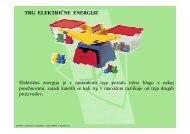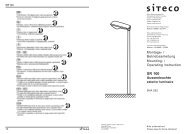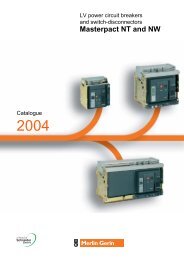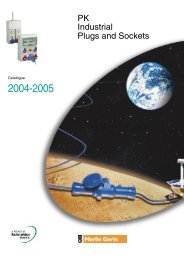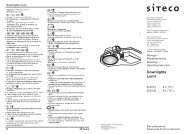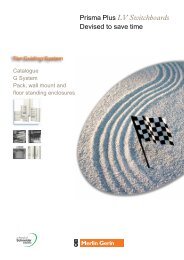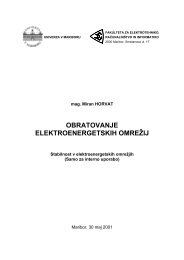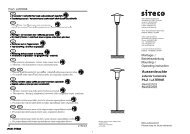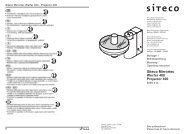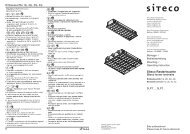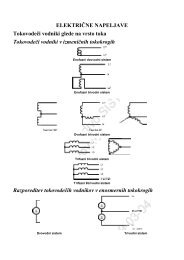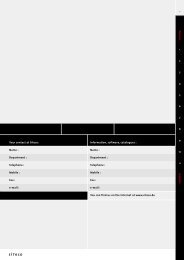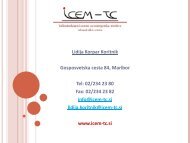Communication Compact NS100 to 630 - POWERLAB
Communication Compact NS100 to 630 - POWERLAB
Communication Compact NS100 to 630 - POWERLAB
You also want an ePaper? Increase the reach of your titles
YUMPU automatically turns print PDFs into web optimized ePapers that Google loves.
Functions and<br />
characteristics<br />
<strong>Communication</strong><br />
<strong>Compact</strong> <strong>NS100</strong> <strong>to</strong> <strong>630</strong><br />
E91685-54 E90463-25<br />
062052-28<br />
PB101038-26<br />
053172-25<br />
<strong>Communication</strong> with the circuit breaker or<br />
switch-disconnec<strong>to</strong>r is possible using a<br />
number of hardware solutions:<br />
b Advantys OTB Modbus interface module<br />
with built-in inputs/outputs<br />
b Power Meter units (PM500, PM800, etc.)<br />
b Micro Power Server MPS100 TCP IP/<br />
Modbus gateway with six digital alarm<br />
inputs.<br />
These solutions are compatible with<br />
existing installations equipped with<br />
communicating contacts.<br />
The <strong>Compact</strong> NS range can take<br />
advantage of the features of the MPS100,<br />
including au<strong>to</strong>matic notification of alarms<br />
via e-mail and SMS messages.<br />
Advantys OTB Modbus.<br />
Power Meter.<br />
Micro Power Server MPS100.<br />
<strong>Compact</strong> NS equipped with<br />
communicating auxiliary<br />
contacts and mo<strong>to</strong>rmechanism<br />
module.<br />
054481-22<br />
Withdrawable <strong>Compact</strong> NS<br />
on its chassis equipped with<br />
communicating auxiliary<br />
contacts.<br />
In addition <strong>to</strong> existing communication possibilities, new communication solutions<br />
are available for the range:<br />
b Advantys OTB Modbus interface module with 12 inputs/8 outputs built in and<br />
expandable by adding optional modules from the Twido range<br />
b Power Meter units (PM500, PM800, etc.) which can be used <strong>to</strong> set up four levels<br />
of functional units:<br />
v local display of currents, voltages, power, power fac<strong>to</strong>rs, energy, <strong>to</strong>tal harmonic<br />
dis<strong>to</strong>rtion (instantaneous and maximum THD values). The Power Meter units must<br />
be used in conjunction with a TCU measurement module,<br />
v remote display of all the above values via a local network or the internet via a<br />
Modbus/TCP IP gateway (type MPS100, EGX200, etc.). The Power Meter units<br />
must be equipped with a Modbus interface,<br />
v status indications. The Power Meter units must be equipped with IO22 alarm<br />
input/output module and the circuit breaker must be equipped with OF (on/off) and<br />
SDE (fault-trip indication) auxiliary contacts,<br />
v remote opening and closing. A mo<strong>to</strong>r-mechanism module must be added <strong>to</strong> the<br />
circuit breaker equipped for status indications<br />
b MPS100 TCP IP/Modbus gateway with six digital inputs <strong>to</strong> connect OF and SDE<br />
auxiliary contacts (see au<strong>to</strong>matic notification on page 89).<br />
The existing solutions remain available:<br />
b communicating auxiliaries<br />
They replace the standard auxiliaries and connect directly <strong>to</strong> the Digipact bus.<br />
Three equipment levels:<br />
v communicating auxiliary contacts, comprising:<br />
- OF (on/off), SD (trip indication) and SDE (fault-trip indication) contacts<br />
- electronic module<br />
- prefabricated wiring.<br />
v communicating auxiliary contacts and mo<strong>to</strong>r-mechanism module, comprising:<br />
- OF (on/off), SD (trip indication) and SDE (fault-trip indication) contacts<br />
- MCH mo<strong>to</strong>r-mechanism module (220 V AC) (1)<br />
- electronic module<br />
- prefabricated wiring.<br />
v communicating carriage switches for the chassis, comprising:<br />
- CE / CD (connected/disconnected position) contacts<br />
- electronic module<br />
- wiring connec<strong>to</strong>r<br />
b SC150 interface<br />
Using the SC150 interface, it is possible <strong>to</strong> integrate a device equipped with noncommunicating<br />
auxiliaries in<strong>to</strong> a supervison system.<br />
The SC150 interface is used <strong>to</strong> connect:<br />
v the auxiliary contacts on the circuit breaker (OF, SD, SDE, SDV, CD, CE)<br />
v the remote-operation system (on, off, reset)<br />
v the communication output for the STR53UE and STR43ME electronic trip units<br />
equipped with the COM option.<br />
Software<br />
To make use of the information provided by the communicating devices, it is<br />
necessary <strong>to</strong> use software incorporating a Modbus driver. Schneider Electric offers<br />
two solutions: the RCU utility and SMS software.<br />
RCU utility<br />
This is a set of Modbus drivers that, in conjunction with a PC, can be used <strong>to</strong>:<br />
b view device status (on/off and fault trip),<br />
b view variables: currents, voltages, power, power fac<strong>to</strong>rs, energy, <strong>to</strong>tal harmonic<br />
dis<strong>to</strong>rtion (instantaneous and maximum THD values),<br />
b remotely open and close the device.<br />
SMS (System Management Software)<br />
SMS is power-management software <strong>to</strong> control and moni<strong>to</strong>r LV and MV electrical<br />
installations.<br />
The SMS family includes a number of products offering different features for all<br />
types of applications.<br />
SMS can communicate with all intelligent devices in the electrical installation<br />
including:<br />
b Power Meter and Circuit Moni<strong>to</strong>r products<br />
b LV circuit breakers and switch-disconnec<strong>to</strong>rs<br />
b Sepam units.<br />
054516-10<br />
SC150 indication and<br />
control interface.<br />
(1) For voltages other than 220 V AC, use a standard mo<strong>to</strong>r-mechanism module (noncommunicating)<br />
<strong>to</strong>gether with an SC150 indication and control interface.<br />
80
IEC947-2<br />
UTE VDE BS CEI UNE NEMA<br />
1<br />
.9<br />
x 250A<br />
.8<br />
push<br />
<strong>to</strong><br />
trip<br />
Im<br />
9<br />
8<br />
10 5<br />
125/160<br />
7<br />
x 250A<br />
6<br />
Ir<br />
Im<br />
250A/40°C<br />
O<br />
push O F<br />
I<br />
push ON<br />
IEC947-2<br />
UTE VDE BS CEI UNE NEMA<br />
1<br />
.9<br />
x 250A<br />
.8<br />
push<br />
<strong>to</strong><br />
trip<br />
Im<br />
9<br />
8<br />
10 5<br />
125/160<br />
7<br />
x 250A<br />
6<br />
Ir<br />
Im<br />
250A/40°C<br />
O<br />
push O F<br />
I<br />
push ON<br />
IEC947-2<br />
1<br />
.9<br />
x 250A<br />
.8<br />
push<br />
<strong>to</strong><br />
trip<br />
Im<br />
9<br />
8<br />
10 5<br />
x 250A<br />
125/160<br />
6<br />
7<br />
Ir<br />
Im<br />
250A/40°C<br />
IEC947-2<br />
UTE VDE BS CEI UNE NEMA<br />
1<br />
.9<br />
x 250A<br />
.8<br />
push<br />
<strong>to</strong><br />
trip<br />
Im<br />
9<br />
8<br />
10 5<br />
x 250A<br />
125/160<br />
6<br />
7<br />
Ir<br />
Im<br />
250A/40°C<br />
IEC947-2<br />
UTE VDE BS CEI UNE NEMA<br />
1<br />
.9<br />
x 250A<br />
.8<br />
push<br />
<strong>to</strong><br />
trip<br />
Im<br />
9<br />
8<br />
10 5<br />
x 250A<br />
125/160<br />
6<br />
7<br />
Ir<br />
Im<br />
250A/40°C<br />
O<br />
push O F<br />
I<br />
push ON<br />
Overview of functions<br />
DB105136<br />
O O F discharged<br />
O O F discharged<br />
Ir TM 250 D<br />
Ir TM 250 D<br />
Ir TM 250 D<br />
Ir TM 250 D<br />
O O F discharged<br />
UTE VDE BS CEI UNE NEMA<br />
Ir TM 250 D<br />
: wiring<br />
: communication bus<br />
: Modbus bus<br />
: Ethernet<br />
<strong>Compact</strong> equipped with:<br />
Advantys OTB PM500/800 Communicating SC150<br />
Modbus + interfaces auxiliaries<br />
Device identification<br />
Address b b b b<br />
Indication of status conditions<br />
OF (on/off) b b b b<br />
SD (trip indication) b - b b<br />
SDE (fault-trip indication) b b b b<br />
CE/CD (connected/disconnected position) b - b b<br />
Controls<br />
ON/OFF - b b b<br />
LED reset - - b b<br />
Protection settings<br />
Reading of the protection settings - - - b<br />
Operating and maintenance aids<br />
Measurements Currents - b - b<br />
Voltages, power, power fac<strong>to</strong>rs, - b - -<br />
energy, THD - b - -<br />
Fault readings Type of fault - - - b<br />
Indications Operation counter - - - b<br />
81
CT<br />
CD<br />
CE<br />
CT<br />
CD<br />
CE<br />
Functions and<br />
characteristics<br />
<strong>Communication</strong><br />
<strong>Compact</strong> NS<strong>630</strong>b <strong>to</strong> 1600<br />
COM option in <strong>Compact</strong><br />
056431<br />
The COM option is required for integration<br />
of the circuit breaker or switchdisconnec<strong>to</strong>r<br />
in a supervision system.<br />
<strong>Compact</strong> uses the Digipact or Modbus<br />
communications pro<strong>to</strong>col for full<br />
compatibility with the SMS PowerLogic<br />
electrical-installation management<br />
systems. An external gateway is available<br />
for communication on other networks:<br />
b Profibus<br />
b Ethernet…<br />
The eco COM is limited <strong>to</strong> the transmission<br />
of metering data and does not allow the<br />
control of the circuit breaker.<br />
Digipact "device"<br />
communication module.<br />
For fixed circuit breakers, the COM option is made up of:<br />
b a "device" communication module, installed behind the Micrologic control unit<br />
and supplied with its set of sensors (OF, SD, SDE micro-contacts for manually<br />
operated devices; OF, SDE micro-contacts for electrically operated devices) and its<br />
kit for connection <strong>to</strong> a communicating mo<strong>to</strong>r-mechanism module.<br />
For withdrawable circuit breakers, the COM option is made up of:<br />
b a "device" communication module, installed behind the Micrologic control unit<br />
and supplied with its set of sensors (OF, SD, SDE micro-contacts for manually<br />
operated devices; OF, SDE micro-contacts for electrically operated devices) and its<br />
kit for connection <strong>to</strong> a communicating mo<strong>to</strong>r-mechanism module<br />
b a "chassis" communication module supplied separately with its set of sensors<br />
(CE, CD and CT contacts).<br />
Status indication by the COM option is independent of the circuit breaker indication<br />
contacts. These contacts remain available for conventional uses.<br />
Digipact or Modbus "device" communication module<br />
This module is independent of the control unit. It receives and transmits information<br />
on the communication network. An infra-red link transmits data between the control<br />
unit and the communication module. Consumption: 30 mA, 24 V.<br />
Digipact or Modbus "chassis" communication module<br />
This module is independent of the control unit. The Modbus "chassis"<br />
communication module makes it possible <strong>to</strong> address the chassis and <strong>to</strong> maintain<br />
the address when the circuit breaker is in the disconnected position.<br />
Consumption: 30 mA, 24 V.<br />
Communicating mo<strong>to</strong>r-mechanism module<br />
A bus link is used <strong>to</strong> transmit remote ON/OFF orders <strong>to</strong> the circuit breaker.<br />
A communicating mo<strong>to</strong>r-mechanism module must be used.<br />
The remote-tripping function (MX or MN) is independent of the communication<br />
option. It therefore has no connec<strong>to</strong>rs for the "device" communication module.<br />
056401<br />
Digipact "chassis"<br />
communication module<br />
DB105192<br />
<strong>Communication</strong><br />
bus<br />
<strong>Communication</strong><br />
bus<br />
OF<br />
SD<br />
SDE<br />
3<br />
OF<br />
SDE<br />
3<br />
1<br />
1<br />
5<br />
I on<br />
E45183 056431<br />
Modbus "device"<br />
communication module<br />
Modbus "chassis"<br />
communication module<br />
1<br />
Manually operated<br />
fixed device<br />
<strong>Communication</strong><br />
bus<br />
CCM modbus<br />
CD<br />
+ +<br />
+<br />
CT<br />
CE<br />
OF<br />
SD<br />
SDE<br />
tripped<br />
reset<br />
0 OFF<br />
2<br />
4<br />
3<br />
<strong>Communication</strong><br />
bus<br />
1<br />
Electrically operated<br />
fixed device<br />
CCM modbus<br />
CD<br />
+ +<br />
+<br />
CT<br />
CE<br />
OF<br />
SDE<br />
2<br />
4<br />
3<br />
5<br />
Manually operated<br />
withdrawable device<br />
Electrically operated<br />
withdrawable device<br />
1 "device" communication module<br />
2 "chassis" communication module<br />
3 OF, SD, SDE "device" sensors<br />
4 CE, CD and CT "chassis" sensors<br />
5 communicating mo<strong>to</strong>r-mechanism<br />
module<br />
82
Overview of functions<br />
E47071<br />
POWERLOGIC System Manager Demo<br />
File Edit View Setup Control Display Tools<br />
Reports Window Help<br />
Sampling Mode : MANUAL 5 seconds<br />
Time<br />
Event<br />
Module<br />
Phase A-N Voltage - Harmonics Analysis<br />
% Fundamental<br />
Phase 1-N<br />
1,20<br />
Harmonics(RMS)<br />
Fundamental: H1: 118.09<br />
H2: 0.01<br />
1,00<br />
RMS:<br />
H3: 0.45<br />
H4: 0.03<br />
H5: 0.45<br />
RMS-H:<br />
H6: 0.04<br />
H7: 1.27<br />
0,80<br />
Peak:<br />
H8: 0.05<br />
H9: 0.42<br />
CF:<br />
H10: 0.01<br />
H11: 1.03<br />
THD:<br />
H12: 0.07<br />
0,60<br />
OK<br />
0,40<br />
<strong>Compact</strong> circuit breakers and switch-disconnec<strong>to</strong>rs are compatible with the<br />
Digipact or Modbus COM option.<br />
The COM option may be used with all types of control units <strong>to</strong>:<br />
b identify the device<br />
b indicate status conditions<br />
b control the device.<br />
Depending on the different types of Micrologic (S, A) control units, the COM option<br />
also offers:<br />
b setting of the protections functions<br />
b analysis of the AC-power parameters for operating-assistance and maintenance<br />
purposes<br />
0,20<br />
Ready<br />
0,00<br />
H2 H3 H4 H5 H6 H7 H8 H9 H10 H11 H12<br />
Harmonics<br />
ONLINE: DEMO No working system 9:30<br />
Switch-disconnec<strong>to</strong>r with Circuit breaker with<br />
communication bus communication bus<br />
Digipact Modbus Digipact Modbus<br />
Device identification<br />
Address b b S A S A<br />
Rating - - A A<br />
Type of device - -<br />
Type of control unit - - A A<br />
Type of long-time rating plug - - A A<br />
Status indications<br />
OF (on/off) b b S A S A<br />
SD (trip indication) b b S A S A<br />
SDE (fault-trip indication) b b S A S A<br />
CE/CD (connected/ b b S A S A<br />
disconnected position)<br />
Controls<br />
MX/XF ON/OFF b b S A S A<br />
Spring charging - -<br />
Reset of the mechanical - -<br />
indica<strong>to</strong>r<br />
Protections settings<br />
Reading of protections settings A A<br />
Operating and maintenance aids<br />
Measurements<br />
current A A<br />
Fault readings<br />
type of fault<br />
A<br />
Note.<br />
S = Micrologic 2.0 and 5.0<br />
A = Micrologic with ammeter<br />
See the description of the Micrologic control units for further details on protection.<br />
Eco COM<br />
The eco COM Modbus is intended <strong>to</strong> fit the circuit breaker with a module display<br />
(DMB300, DMC300…).<br />
83
pulsar SV<br />
OK<br />
e ror<br />
N°1 N°1<br />
BBus<br />
com<br />
24V<br />
JBus<br />
com<br />
e ror<br />
Functions and<br />
characteristics<br />
<strong>Communication</strong><br />
<strong>Compact</strong> NS<strong>630</strong>b <strong>to</strong> 1600 (cont.)<br />
<strong>Compact</strong> in a communication network<br />
E94525<br />
Software<br />
<strong>Communication</strong><br />
interface<br />
RS 232C, Ethernet<br />
RS 485<br />
<strong>Communication</strong><br />
bus<br />
MERLIN GERIN<br />
1 3<br />
Data concentra<strong>to</strong>r<br />
DC150<br />
Device<br />
Digipact Bus<br />
Modbus Bus<br />
<strong>Compact</strong><br />
<strong>Compact</strong><br />
Devices<br />
Circuit breakers equipped with Micrologic control units may be connected <strong>to</strong> either<br />
a Digipact or Modbus communication bus. The information made available<br />
depends on the type of Micrologic control unit (A, P or H) and on the type of<br />
communication bus (Digipact or Modbus).<br />
Switch-disconnec<strong>to</strong>rs can be connected <strong>to</strong> the Digipact or Modbus communication<br />
bus. The information made available is the status of the switch-disconnec<strong>to</strong>r.<br />
<strong>Communication</strong> bus<br />
Digipact bus<br />
The Digipact bus is the internal bus of the low-voltage switchboard in which the<br />
Digipact communicating devices are installed (<strong>Compact</strong> with Digipact COM,<br />
PM150, SC150, UA150, etc.). This bus must be equipped with a DC150 data<br />
concentra<strong>to</strong>r (see the Powerlogic System catalogue).<br />
Addresses<br />
Addressing is carried out by the DC150 data concentra<strong>to</strong>r.<br />
Number of devices<br />
The maximum number of devices that may be connected <strong>to</strong> the Digipact bus is<br />
calculated in terms of “communication points”. These points correspond <strong>to</strong> the<br />
amount of traffic the bus can handle. The <strong>to</strong>tal number of points for the various<br />
devices connected <strong>to</strong> a single bus must not exceed 100.<br />
If the required devices represent more than 100 points, add a second Digipact<br />
internal bus.<br />
Communicating device Number of points<br />
DC150 data concentra<strong>to</strong>r 4<br />
Micrologic + Digipact COM 4<br />
PM150 4<br />
SC150 4<br />
UA150 4<br />
Length of bus<br />
The maximum recommended length for the Digipact internal bus is 200 meters.<br />
Bus power source<br />
Power is supplied by the DC150 data concentra<strong>to</strong>r (24 V).<br />
84
Modbus bus<br />
The Modbus RS 485 (RTU pro<strong>to</strong>col) system is an open bus on which<br />
communicating Modbus devices (<strong>Compact</strong> with Modbus COM, Power Meter<br />
PM500, PM800, Sepam, Vigilohm, etc.) are installed. All types of PLCs and<br />
microcomputers may be connected <strong>to</strong> the bus.<br />
Addresses<br />
The Modbus parameters (address, baud rate, parity) are entered using the keypad<br />
on the Micrologic A, P or H. For a switch-disconnec<strong>to</strong>r, it is necessary <strong>to</strong> use the<br />
RSU (Remote Setting Utility) Micrologic utility.<br />
The software layer of the Modbus pro<strong>to</strong>col can manage up <strong>to</strong> 255 addresses<br />
(1 <strong>to</strong> 255).<br />
The “device” communication module comprises three addresses linked <strong>to</strong>:<br />
b circuit-breaker manager<br />
b measurement manager<br />
b protection manager.<br />
The “chassis” communication module comprises one address linked <strong>to</strong>:<br />
b the chassis manager.<br />
The division of the system in<strong>to</strong> four managers secures data exchange with the<br />
supervision system and the circuit-breaker actua<strong>to</strong>rs.<br />
The manager addresses are au<strong>to</strong>matically derived from the circuit-breaker address<br />
@xx entered via the Micrologic control unit (the default address is 47).<br />
logic addresses<br />
@xx Circuit-breaker manager (1 <strong>to</strong> 47)<br />
@xx + 50 Chassis manager (51 <strong>to</strong> 97)<br />
@xx + 200 Measurement manager (201 <strong>to</strong> 247)<br />
@xx + 100 Protection manager (101 <strong>to</strong> 147)<br />
Number of devices<br />
The maximum number of devices that may be connected <strong>to</strong> the Modbus bus<br />
depends on the type of device (<strong>Compact</strong> with Modbus COM, PM500, PM700,<br />
PM800, Sepam, Vigilohm, etc.), the baud rate (19200 is recommended), the<br />
volume of data exchanged and the desired response time. The RS 485 physical<br />
layer offers up <strong>to</strong> 32 connection points on the bus (1 master, 31 slaves).<br />
A fixed device requires only one connection point (communication module on the<br />
device).<br />
A drawout device uses two connection points (communication modules on the<br />
device and on the chassis).<br />
The number must never exceed 31 fixed devices or 15 drawout devices.<br />
Length of bus<br />
The maximum recommended length for the Modbus bus is 1200 meters.<br />
Bus power source<br />
A 24 V DC power supply is required (less than 20 % ripple, insulation class II).<br />
<strong>Communication</strong> interface<br />
The Modbus bus may be connected <strong>to</strong> the central processing device in any of<br />
three manners:<br />
b direct link <strong>to</strong> a PLC. The communication interface is not required if the PLC is<br />
equipped with a Modbus port;<br />
b direct link <strong>to</strong> a computer. The Modbus (RS 485) / Serial port (RS 232)<br />
communication interface is required;<br />
b connection <strong>to</strong> a TCP/IP (Ethernet) network. The Modbus (RS 485) / TCP/IP<br />
(Ethernet) communication interface is required.<br />
Software<br />
To make use of the information provided by the communicating devices, software<br />
with a Modbus driver must be used.<br />
Micrologic utilities<br />
This is a set of Modbus drivers that may be used with a PC <strong>to</strong>:<br />
b display the variables (I, U, P, E, etc.) with the RDU (Remote Display Utility)<br />
b read/write the settings with the RSU (Remote Setting Utility)<br />
b remotely control (ON / OFF) the device with the RCU (Remote Control Utility).<br />
These utilities are available on request.<br />
System Manager Software (SMS)<br />
SMS is a power management software for the control and moni<strong>to</strong>ring of LV and MV<br />
electrical installations.<br />
The SMS family includes a number of products for all types of applications, from<br />
standalone systems <strong>to</strong> networked power management of multiple buildings.<br />
SMS can communicate with all intelligent devices of the electrical installation<br />
including:<br />
b Power Meter and Circuit Moni<strong>to</strong>r products<br />
b LV circuit breakers and switch-disconnec<strong>to</strong>rs<br />
b Sepam units.<br />
85
Functions and<br />
characteristics<br />
<strong>Communication</strong><br />
<strong>Compact</strong> NS1600b <strong>to</strong> 3200<br />
COM option in <strong>Compact</strong><br />
The COM option is required for integration<br />
of the circuit breaker or switchdisconnec<strong>to</strong>r<br />
in a supervision system.<br />
<strong>Compact</strong> uses the Digipact or Modbus<br />
communications pro<strong>to</strong>col for full<br />
compatibility with the SMS PowerLogic<br />
electrical-installation management<br />
systems. An external gateway is available<br />
for communication on other networks:<br />
b Profibus<br />
b Ethernet…<br />
For fixed circuit breakers, the COM option is made up of:<br />
b a "device" communication module, installed behind the Micrologic control unit<br />
and supplied with its set of sensors (OF, SD, SDE micro-contacts).<br />
Status indication by the COM option is independent of the circuit breaker indication<br />
contacts. These contacts remain available for conventional uses.<br />
Digipact or Modbus "device" communication module<br />
This module is independent of the control unit. It receives and transmits information<br />
on the communication network. An infra-red link transmits data between the control<br />
unit and the communication module.<br />
Consumption: 30 mA, 24 V.<br />
E59438<br />
<strong>Communication</strong><br />
bus<br />
056431<br />
Digipact "device"<br />
communication module.<br />
OF<br />
SD<br />
SDE<br />
2<br />
1<br />
OFF OFF<br />
COM<br />
module<br />
056431<br />
Modbus "device"<br />
communication module<br />
1 "Device" communication module<br />
2 OF, SD, SDE "device" sensors<br />
86
Overview of functions<br />
E47071<br />
POWERLOGIC System Manager Demo<br />
File Edit View Setup Control Display Tools<br />
Reports Window Help<br />
Sampling Mode : MANUAL 5 seconds<br />
Time<br />
Event<br />
Module<br />
Phase A-N Voltage - Harmonics Analysis<br />
% Fundamental<br />
Phase 1-N<br />
1,20<br />
Harmonics(RMS)<br />
Fundamental: H1: 118.09<br />
H2: 0.01<br />
1,00<br />
RMS:<br />
H3: 0.45<br />
H4: 0.03<br />
H5: 0.45<br />
RMS-H:<br />
H6: 0.04<br />
H7: 1.27<br />
0,80<br />
Peak:<br />
H8: 0.05<br />
H9: 0.42<br />
CF:<br />
H10: 0.01<br />
H11: 1.03<br />
THD:<br />
H12: 0.07<br />
0,60<br />
OK<br />
0,40<br />
<strong>Compact</strong> circuit breakers and switch-disconnec<strong>to</strong>rs are compatible with the<br />
Digipact or Modbus COM option.<br />
The COM option may be used with all types of control units <strong>to</strong>:<br />
b identify the device<br />
b indicate status conditions<br />
b control the device.<br />
Depending on the different types of Micrologic (S, A) control units, the COM option<br />
also offers:<br />
b setting of the protections functions<br />
b analysis of the AC-power parameters for operating-assistance and maintenance<br />
purposes<br />
Ready<br />
0,20<br />
0,00<br />
H2 H3 H4 H5 H6 H7 H8 H9 H10 H11 H12<br />
Harmonics<br />
ONLINE: DEMO No working system 9:30<br />
Switch-disconnec<strong>to</strong>r with Circuit breaker with<br />
communication bus communication bus<br />
Digipact Modbus Digipact Modbus<br />
Device identification<br />
Address b b S A S A<br />
Rating - - A A<br />
Type of device - -<br />
Type of control unit - - A A<br />
Type of long-time rating plug - - A A<br />
Status indications<br />
OF (on/off) b b S A S A<br />
SD (trip indication) b b S A S A<br />
SDE (fault-trip indication) b b S A S A<br />
Protections settings<br />
Reading of protections settings A A<br />
Operating and maintenance aids<br />
Measurements<br />
current A A<br />
Fault readings<br />
type of fault<br />
A<br />
Note.<br />
See the description of the Micrologic control units for further details on protection.<br />
87
Functions and<br />
characteristics<br />
<strong>Communication</strong><br />
<strong>Compact</strong> and the MPS100<br />
Micro Power Server<br />
E90463<br />
E91685-60<br />
The MPS100 Micro Power Server:<br />
b notifies maintenance staff when<br />
any preset alarm or trip is activated<br />
by the Micrologic trip unit, au<strong>to</strong>matically<br />
sending an e-mail and/or SMS<br />
b data logs are periodically forwarded<br />
by e-mail<br />
b the e-mails are sent via an Ethernet local<br />
area network (LAN) or remotely<br />
via modem.<br />
Micro Power Server makes data collection easy<br />
for moni<strong>to</strong>ring Masterpact / <strong>Compact</strong> circuit breakers<br />
Now, more than ever, there is a need <strong>to</strong> moni<strong>to</strong>r electrical distribution systems in<br />
industrial and large commercial applications. The key <strong>to</strong> managing all equipment,<br />
maximising efficiencies, reducing costs and increasing up time is having the right<br />
<strong>to</strong>ols.<br />
Micro Power Server MPS100 is designed <strong>to</strong> withstand harsh electrical<br />
environments and provide a consistent flow of easy <strong>to</strong> interpret information.<br />
Micro Power Server is designed for unattended operation<br />
within the main LV switchboard<br />
The MPS100 is a self-contained facility information server that serves as a standalone<br />
device for power system moni<strong>to</strong>ring.<br />
It is used <strong>to</strong> transfer power system information via a standard web browser over<br />
an Ethernet local area network (LAN) or via modem, making it possible <strong>to</strong> view<br />
power system information on a PC with an Ethernet connection.<br />
In either capacity, the Micro Power Server functions as a web server for Micrologic<br />
trip unit and Power Meter (PM500) supervision, au<strong>to</strong>matically notifying (e-mail<br />
and/or SMS) maintenance staff when any preset alarm or trip is activated in<br />
the Micrologic trip unit.<br />
DB100435 056993<br />
MPS100 Micro Power Server.<br />
Main LV switchboard.<br />
Benefits<br />
b view your main LV switchboard without installing software on your local PC,<br />
eliminating the need for a dedicated PC with specific software<br />
b Micro Power Server allows centralised moni<strong>to</strong>ring, so you no longer waste<br />
precious time walking around the facility <strong>to</strong> collect data<br />
b view your main LV switchboard via a modem connection (GSM or switched<br />
network), avoiding the need for a LAN<br />
b maintenance people are au<strong>to</strong>matically notified at any time, wherever they are,<br />
so you do not have <strong>to</strong> stay in front of a moni<strong>to</strong>r all day long<br />
b data logs can be periodically forwarded by sending e-mails <strong>to</strong> the relevant people<br />
(maintenance, accounting, application service provider) au<strong>to</strong>matically<br />
b possibility <strong>to</strong> moni<strong>to</strong>r/notify six external events (limit switches, auxiliary<br />
switches...)<br />
b back-up of Micrologic trip unit settings in the memory of the MPS100, so you<br />
know where <strong>to</strong> retrieve it when necessary.<br />
Moni<strong>to</strong>ring of the main LV switchboard via Web pages<br />
embedded in the MPS100 and accessible via a standard Web<br />
browser.<br />
88
Typical architecture<br />
056993-34<br />
Au<strong>to</strong>matic notification<br />
Modbus I/O MPS100<br />
+ -<br />
+ -<br />
+ -<br />
Modem<br />
GSM<br />
SMS<br />
Modem<br />
ISP WEB<br />
OF<br />
SDE<br />
e-mail<br />
Moni<strong>to</strong>ring from office PC<br />
Modbus I/O MPS100<br />
Hub<br />
LAN<br />
LAN<br />
Moni<strong>to</strong>ring from home PC<br />
Modbus I/O MPS100<br />
DB103808<br />
Modem<br />
GSM<br />
Modem<br />
It is possible <strong>to</strong> combine the different types of architecture.<br />
E89544-14<br />
E95405R<br />
Micrologic trip unit.<br />
062052-15<br />
Power Meter PM500.<br />
Main switchboard at<br />
Plaza hotel.<br />
Air conditioning breaker<br />
tripped on ground fault<br />
Ig = 350 A.<br />
06:37 on 10/12/2002<br />
Supported Modbus devices<br />
b Micrologic trip units<br />
b Power Meters (PM500, PM700, PM800, …).<br />
Maximum recommended connected devices is 10.<br />
Features<br />
b access <strong>to</strong> the power system via a standard PC web browser<br />
b real-time data displayed with an intuitive and user friendly interface<br />
(dashboard)<br />
b Ethernet Modbus TCP/IP connectivity directly <strong>to</strong> the LAN or via modem (Point <strong>to</strong><br />
Point Pro<strong>to</strong>col services)<br />
b SMTP (Simple Mail Transfer Pro<strong>to</strong>col) client (capacity <strong>to</strong> send e-mail)<br />
b local logging of data such as energy, power, current…<br />
b set-up and system configuration through MPS100 embedded HTML pages<br />
b user interface translatable in any language, fac<strong>to</strong>ry settings in English and<br />
French<br />
b 6 inputs/2 outputs (no-volt contact)<br />
b DHCP (Dynamic Host Configuration Pro<strong>to</strong>col) client.<br />
Technical characteristics<br />
Power supply<br />
24 V DC ±15 %, consumption = 250 mA<br />
Operating temperature 0 <strong>to</strong> +50 °C<br />
Rugged compact metal housing 35 x 218 x 115 mm (H x W x D)<br />
Additional information available at: http://194.2.245.4/mkt/microser.nsf<br />
User name: MPS, Password: MPS100<br />
Short Message Service (SMS).<br />
Part numbers<br />
Micro Power Server MPS100 33507<br />
89



